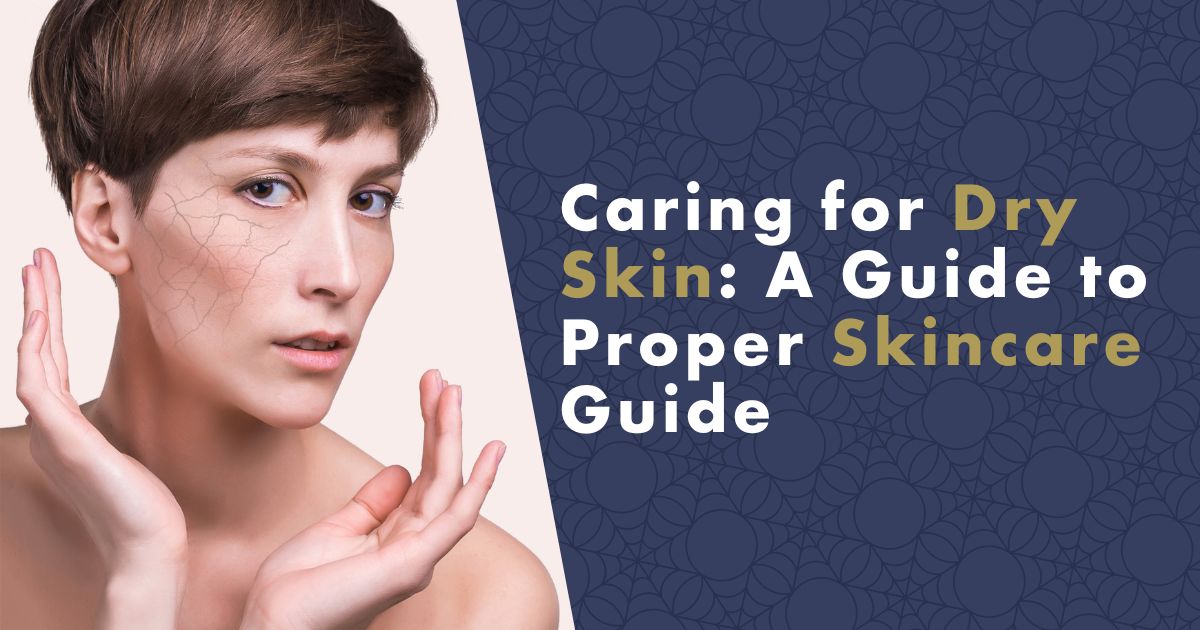
Dry skin can appear rough, scaly, and unsightly. It usually manifests as red, itchy patches on common body parts like the arms, hands, elbows, and ankles, but it can also affect other areas such as the stomach or legs. In severe cases, dry skin may cause cracking. This article provides a comprehensive guide on how to properly care for dry skin.

What Causes Dry Skin?
Dry skin can be inherited, passed down from parents or grandparents. But it is more commonly associated with aging, as the skin's natural oil production decreases. Medical conditions like asthma or thyroid disease can also contribute to dry skin.
Bad skincare habits like using harsh soaps, excessive use of sanitizers, and using low-quality or unsuitable cosmetics can further worsen dry skin.
Making simple changes to your daily skincare routine can help keep dry skin hydrated and healthy. Regardless of the underlying cause, there are effective solutions to manage dry skin.
Symptoms of Dermatitis
Sometimes it can be dry skin a sign of dermatitis, let's imagine its types.
- Seborrheic dermatitis: a type of dermatitis marked by a red, scaly, itchy rash on areas of the body with high sebaceous gland density (e.g. scalp, eyebrows, nose).
- Allergic contact dermatitis: occurs when the skin reacts to an allergen (e.g. poison ivy) by coming into contact with it, often leading to peeling of the fingers.
- Atopic dermatitis (eczema): a long-term dermatitis that can cause dry, itchy skin.
Tip: What helps for atopic eczema? You will find out in the following article.
What Should Not Be Missing From a Moisturizer?
It is not necessary to pay a lot of money for a good, quality and nutrient-rich one moisturizer.
Among the ingredients that can be useful for dry skin, includes:
- Ceramides: Ceramides aid in retaining skin hydration and soothe dry skin. Synthetic ceramides mimic the natural substances in the skin's outer layer to keep moisture in.
- Dimethicone and glycerin: These ingredients attract and retain water in the skin.
- Hyaluronic acid: Like ceramides, hyaluronic acid helps retain skin hydration.
- Lanolin, mineral oil, and petroleum jelly: These help keep skin hydrated after bathing. Purchase creams with at least SPF 15 and apply to skin when exposed to sunlight for added protection.
Hyaluronic Acid
Hyaluronic acid has incredible moisturizing abilities, able to hold up to 1000 times its molecular weight in water.
It penetrates the skin deeply and binds water to skin cells, providing deep hydration. It also acts as a humectant, attracting moisture from the environment.
#produkty#https://www.nanospace.store/search/?string=cream+nafigate+hyaluron
If your skin is more prone to sagging quickly due to dryness, the topical use of hyaluronic acid can prevent this. It provides the skin with more moisture, softens the face, and gives it a youthful and plumper appearance.
If you desire a smooth, pore-free skin texture but your dry skin is not cooperating, hyaluronic acid can help. By increasing skin elasticity and reducing roughness by filling the skin with moisture, it improves overall appearance and reduces unwanted bumps and lines.
Dry skin often tends to develop signs of aging more quickly, but hyaluronic acid comes to the rescue. By increasing skin elasticity and firmness, it reduces the depth of wrinkles and fine lines disappear easily.
Protect Your Skin from Dryness: Tips for Keeping It Hydrated
Wash Your Face Gently Twice a Day. Use a Gentle Cleanser or Foam Without Alcohol. Products with Stearic Acid (found in Bamboo Butter) or Linoleic Acid (found in Argan Oil) Can Help with Dry Skin Issues.

Use moisturizer, which contains SPF 15 and more, even on cloudy days. Apply the cream in sufficient quantity and repeat several times during the day.
Tip: Moisturize your skin with moisturizing nanofiber mask nanoBeauty.
You can also visit a dermatologist to consult about the condition of your skin. You may need to try several products before finding the ones you like, that work for you, and that you use regularly.
Look for ingredients and substances in products that will help you with skin hydration such as ceramides, hyaluronic acid, fatty acids, glycerol (also known as glycerin), bamboo butter, and cocoa butter.
Seek out fragrance-free products that don't cause acne (non-comedogenic) and don't contain substances that cause allergies (hypoallergenic). Avoid products containing sodium lauryl sulfate, which can dry out your skin.
#produkty#https://www.nanospace.store/search/?string=acne
Use a suitable cream, hydrating body milk, or serum for both your face and neck. Choose a product that's easy to apply and doesn't leave a visible residue. If you have acne-prone skin, avoid facial products with petroleum jelly, cocoa butter, or coconut oil.
For mature skin, steer clear of products with alpha hydroxy acids to prevent flaky dry skin. Many moisturizers serve as the base for anti-wrinkle creams, with added ingredients like retinoids, antioxidants, and peptides.
If you have dry hands or feet, use a moisturizing cream or oil. The oil lasts longer and prevents water evaporation from the skin surface. Petroleum jelly-based products are also an option, but may be too greasy. Use only before bed or on small skin cracks if needed.
Take shorter showers with warm water to protect your skin's natural oils. Limit shower time to no more than once a day and 5-10 minutes, and avoid hot water.
Tip: Use also hydrating hair and face water for hydration
#produkty#https://www.nanospace.store/search/?string=Gallin%C3%A9e+cream
If you have atopic eczema, opt for gentle and lightweight materials for daily wear and nightwear, such as those made with nanofibers. Natural fibers like cotton allow your skin to breathe and are a good choice. Although wool is a natural fiber, it can sometimes irritate even healthy skin. Avoid using laundry detergents with dyes and perfumes, as they can cause further irritation.
To relieve itching, use a clean, cool, and moist cloth, or try an anti-itch cream or tonic containing at least 1% hydrocortisone. If these methods don't provide relief or if your symptoms worsen, consult a dermatologist or doctor.
4 Essential Tips for Dry Skin in Spring and Winter
As spring temperatures fluctuate (with chilly mornings still in full swing), it's not uncommon to notice changes in your skin due to the weather. One of the biggest culprits is dry air, which can lead to skin tightness, accentuated wrinkles and unevenness, disrupted natural protective layers, and even acne breakouts. If this sounds familiar, read on!
The relationship between the humidity of the air and the hydration of your skin is clear - our skin reacts to the environment it's in. So how can you keep your skin hydrated and protected when the weather is dry and cold?
Here are several tried-and-true tips to help you maintain hydrated, protected skin during the transition from winter to spring.
Use a Humidifier
Humidifiers add moisture to indoor spaces, which is crucial not only for maintaining healthy skin, but overall health as well. During winter, the use of fireplaces and heating can greatly dry out the air inside our homes, making it necessary to use a humidifier to add extra hydration.

Beware the Drying Effects of a Hot Bath
A hot bath may sound enticing after a long day, but it can actually strip the skin of its moisture, causing excessive dryness. To combat the dry winter weather, opt for a lukewarm bath instead of a hot one, and follow up with nourishing, hydrating creams or oils to lock in moisture and protect the skin from drying out.
Transform Your Skincare Routine: Hydrate and Protect Your Skin
If you're still using the same products you used in summer, your skin is likely not getting the hydration it needs. Change your routine and switch to skin care products that are rich in vitamins and oils, and are specially designed for use during the colder months. Replace harsh cleansing foams with gentler cleansing products, and use nourishing night creams to keep your skin healthy.
Revitalize Your Skin with Moisturizing Face Masks
Wet and cold fabric masks don't sound very appealing in the winter - and it doesn't matter how effective the ingredients are. Fortunately, there are other options - dry nanofiber masks. The best way to thoroughly hydrate and nourish your skin is using inert masks in combination with your favorite serum, moisturizing day or night cream.
#produkty#https://www.nanospace.store/search/?string=dry+sheet
Inert masks are created so that your favorite product is better absorbed into the skin and your skin used the maximum of contained active ingredients. By using a dry inert nanofiber mask, your skin will be better hydrated and nourished without knocking yourself cold during application.
If you keep these four tips in mind in March, it's easy to put an end to dry skin once and for all.
Resources
- Functions of hyaluronan in wound repair
- Efficacy of a New Topical Nano-hyaluronic Acid in Humans
- Papakonstantinou, E., Roth, M., & Karakiulakis, G. (2012). Hyaluronic acid: A key molecule in skin aging. Dermato-endocrinology, 4(3), 253-258. doi: 10.4161/derm.21923
- Kaya, G., Tran, C., Sorg, O., & Hotz, R. (2006). Hyaluronate fragments reverse skin atrophy by a CD44-dependent mechanism. PloS one, 1(1), e56. doi: 10.1371/journal.pone.0000056
- Boregowda, S. V., Booker, C. N., & Smith, M. K. (2019). Topical Hyaluronic Acid as a Dressing for Dermal Wounds. Advances in wound care, 8(6), 250-257. doi: 10.1089/wound.2017.0765
- Jiang, D., Liang, J., & Noble, P. W. (2007). Hyaluronan in tissue injury and repair. Annual review of cell and developmental biology, 23, 435-461. doi: 10.1146/annurev.cellbio.23.090506.123337
- An, H. J., Kim, K. J., Kim, H. K., Park, K. S., Kim, H. J., & Kim, C. H. (2012). Molecular mechanism of Angelicae Gigantis Radix for collagen production in normal human dermal fibroblasts. Journal of ethnopharmacology, 142(1), 218-224. doi: 10.1016/j.jep.2012.04.021
- Salah, E., & Almazrooa, A. (2018). Hyaluronic Acid: A Promising Skin Rejuvenating Biomedicine. Saudi Journal of Medicine and Medical Sciences, 6(1), 1-6. doi: 10.4103/sjmms.sjmms_68_17
- Wang, F., Garza, L. A., Kang, S., Varani, J., & Orringer, J. S. (2011). An in vivo study of the effect of hyaluronic acid filler injections on facial pores. Journal of cosmetic dermatology, 10(2), 131-138. doi: 10.1111/j.1473-2165.2011.00557.x

Lucie Konečná, from nanoSPACE
Lucie Konečná has been working in the field of nanotechnology for 7 years. She is a co-author of the Czech is Nano project and has been involved in building public awareness of nanotechnology. Lucie has been managing operations of the nanoSPACE e-shop since May 2020.
